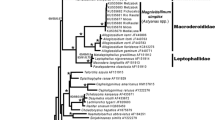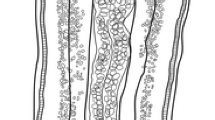Abstract
Phylogenetic interrelationships of 32 species belonging to 18 genera and four families of the superfamily Microphalloidea were studied using partial sequences of nuclear lsrDNA analysed by Bayesian inference and maximum parsimony. The resulting trees were well resolved at most nodes and demonstrated that the Microphalloidea, as represented by the present data-set, consists of three main clades corresponding to the families Lecithodendriidae, Microphallidae and Pleurogenidae + Prosthogonimidae. Interrelationships of taxa within each clade are considered; as a result of analysis of molecular and morphological data, Floridatrema Kinsella & Deblock, 1994 is synonymised with Maritrema Nicoll, 1907, Candidotrema Dollfus, 1951 with Pleurogenes Looss, 1896, and Schistogonimus Lühe, 1909 with Prosthogonimus Lühe, 1899. The taxonomic value of some morphological features, used traditionally for the differentiation of genera within the Lecithodendriidae and Prosthogonimidae, is reconsidered. Previous systematic schemes are discussed from the viewpoint of present results, and perspectives of future studies are outlined.
Similar content being viewed by others
References
Africa, C.M. (1930) Pleurogenes loossi sp. nov. in the intestine of Rana esculenta Germani. Zentralblatt für Bakteriologie, Parasitenkunde und Infektionskrankheiten. I. Abteilung 115, 448–451.
Baer, J.G. (1943) Les trématodes parasites de la musraigne d'eau Neomys fodiens (Schreb.). Bulletin de la Société Neuchâteloise Science Naturelles, 68, 33–84.
Bayssade-Dufour, C., Hugot, J.-P. & Albaret, J.-L. (1993) Analyse phénétique des Microphalloidea (Trematoda) d'après la chétotaxie des cercaires. Systematic Parasitology, 25, 1–24.
Braun, M. (1901) Trematoden der Bursa Fabricii, des Eileiters und der Eier der Vogel. Zentralblatt für Bakteriologie, Parasitenkunde und Infektionskrankheiten, I. Abteilung, 29, 12–19.
Brooks, D.R., O'Grady, R.T. & Glen, D.R. (1985) Phylogenetic analysis of the Digenea (Platyhelminthes: Cercomeria) with comments on their adaptive radiation. Canadian Journal of Zoology, 63, 411–443.
Caballero, E.C. (1961) Trematodos de los murcielagos de Mexico. VIII. Catalogo taxonomico de los trematodos que parasitan a los murcielagos (Mammalia, Chiroptera). Anales del Instituto de Biología, 31, 215–287.
Cribb, T.H., Bray, R.A., Littlewood, D.T.J., Pichelin, S.P. & Herniou, E.A. (2001) The Digenea. In: Littlewood, D.T.J. & Bray, R.A. (Eds) Interrelationships of the Platyhelminthes. London: Taylor & Francis, pp. 168–185.
Deblock, S. (1971) Contribution à l'étude des Microphallidae Travassos, 1920 (Trematoda). XXIV. Tentative de phylogénie et de taxonomie. Bulletin du Muséum National d'Histoire Naturelle, 3ème Série, 7, Zoologie, 7, 353–468.
Dubois, G. (1960) Contribution à l'étude des Trématodes de Chiroptères. Revision du sous-genre Prosthodendrium Dollfus, 1931 et des genres Lecithodendrium Looss, 1896 et Pycnoporus Looss, 1899. Revue Suisse de Zoologie, 67, 1–80.
Dubois, G. (1962) Contribution à l'étude des Trématodes de Chiroptères. Revision du sous-genre Paralecithodendrium Odhner, 1911. Revue Suisse de Zoologie, 69, 385–405.
Huelsenbeck, J.P. (2000) MrBayes: Bayesian inference of phylogeny. Rochester, NY: Department of Biology, University of Rochester.
Huelsenbeck, J.P. & Ronquist, F. (2001) MRBAYES: Bayesian inference of phylogenetic trees. Bioinformatics, 17, 754–755.
Hurková, J. (1959) Prosthodendrium (Prosthodendrium) carolinum n. sp. and some less known bat trematodes in ČSR. Vestnik Československé Zoologické Společnosti, 23, 23–33.
Hurková, J. (1963) Bat trematodes in Czechoslovakia. I. A systematical review of occurring species. Vestnik Československé Zoologické Společnosti, 27, 250–276.
Jeanmougin, F., Thompson, J.D., Gouy, M., Higgins, D.G. & Gibson, T.J. (1998) Multiple sequence alignment with Clustal X. Trends in Biochemical Sciences, 23, 403–5.
Khotenovsky, I.A. (1970) [Family Pleurogenidae Looss, 1899]. Osnovy Trematodologii, 23, 137–296. (In Russian).
Khotenovsky, I.A. (1985) Trematodes of the genus Parabascus (Trematoda, Pleurogenidae) from the bats of the Holarctic. Parazitologicheskii Sbornik, 1985, 125–133. (In Russian).
Kinsella, J.M. (1988) Comparison of helminths of rice rats, Oryzomys palustris, from freshwater and saltwater marshes in Florida. Proceedings of the Helminthological Society of Washington, 55, 275–280.
Kinsella, J.M. & Deblock, S. (1994) Contribution à l'étude des Microphallidae Travassos, 1920 (Trematoda). XLVI. Description de Floridatrema heardi n. gen., n. sp., parasite d'Oryzomys palustris (Mammifere) des États-Unis. Parasite, 1, 45–50.
Looss, A. (1899) Weitere Beitrage zur Kenntnis der Trematodenfauna Aegyptens, zugleich Verseuch einer natürlichen Gliederung des Genus Distomum Reitzius. Zoologischer Jahrbücher, Abteilung für Systematik, 12, 521–784.
Looss, A. (1902) Ñber neue und bekannte Trematoden aus Seeschildkröten. Nebst Erörterungen zur Systematik und Nomenclatur. Zoologischer Jahrbücher, Abteilung für Systematik, 16, 411–894.
Lühe, M.F.W. (1901) Zweie neue Distomen aus indischen Anuren. Zentralblatt für Bakteriologie, Parasitenkunde und Infektionskrankheiten, I. Abteilung, 30, 166–177.
Maddison, W.P. & Maddison, D.R. (2000) MacClade 4: Analysis of Phylogeny and Character Evolution. Version 4.03. Sunderland, Massachusetts: Sinauer Associates.
Morozov, F.N. (1955) [Family Gymnophallidae Morozov, 1955]. Osnovy Trematodologii, 10, 315–335. (In Russian).
Odening, K. (1959) Das Exkretionssystem von Omphalometra und Brachycoelium (Trematoda, Digenea) und die Taxonomie der Unterordnung Plagiorchiata. Zeitschrift für Parasitenkunde, 19, 442–457.
Odening, K. (1964a) Zur Taxonomie der Trematodenunterordnung Plagiorchiata. Monatsberichte der Deutschen Akademie der Wissenschaften zu Berlin. 6, 191–198.
Odening, K. (1964b) Exkretionssystem und systematische Stellung einiger Fledermaustrematoden aus Berlin und Umgebung nebst Bemerkungen zum lecithodendrioiden Komplex. Zeitschrift für Parasitenkunde, 24, 453–483.
Odening, K. (1971) Möglichkeiten der Herstellung des bisher unbekannten Zusammenhangs von Cercarien und adulten Trematoden mit Hilfe detailierter Kenntnisse des Exkretionssystems nebst Ausführungen zum weiteren Ausbau des Systems der Plagiorchiata. Perspektiven der Cercarienforschung.Parasitologische Schriftenreihe, 21, 57–72.
Odhner, T. (1910) Nordostafrikanische Trematoden, grösstenteils vom Weissen Nil (von der schweidischen zoologischen Expedition gesammelt). Results of the Swedish Zoological Expedition to Egypt and White Nile (1901) (Jägerskiöld) (23A), 170 pp.
Olson, P.D., Cribb, T.H., Tkach, V.V., Bray, R.A. & Littlewood, D.T.J. (2003) Phylogeny and classification of the Digenea (Platyhelminthes: Trematoda). International Journal for Parasitology, 33, 733–755.
Posada, D. & Crandall, K.A. (1998) Modeltest: testing the model of DNA substitution. Bioinformatics 14, 817–818.
Prudhoe, S. & Bray, R.A. (1982) Platyhelminth parasites of the Amphibia. London: British Museum (Natural History) and Oxford University Press, 217 pp.
Richard, J. & Prévot, G. (1974) Chétotaxie des cercaires de Gymnophallus nereicola Rebecq et Prévot, 1962 et Gymnophallus fossarum Bartoli, 1965 (Trematoda, Gymnophallidae). Bulletin du Muséum National d'Histoire Naturelle, 3ème Série, 233, Zoologie, 157, 845–853.
Salem J.B. (1971) Studies of the trematodes of bats found in Hederabad, Andhra Pradesh (India). Part: 1. Rivista di Parassitologia, 32, 159–178.
Sharpilo, V.P. & Iskova, N.I. (1989) [The Fauna of the Ukraine: Trematoda: Plagiorchiata.] Fauna Ukrainy, 34, 1–278. (In Russian).
Skarbilovich, T.S. (1948) [Family Lecithodendriidae Odhner, 1911]. Osnovy Trematodologii, 2, 237–590. (In Russian).
Skvortsov, V.G. (1970) [Trematodes of the family Lecithodendriidae from bats in Moldavia]. Parazity Zhivotnych i Restenij. Kishinev: Kartya Moldovenyaske, 5,17–36. (In Russian).
Srivastava, H.D. (1934) On new trematodes of frogs and fishes of the United Provinces, India. Part III. On a new genus Mehraorchis and two new species of Pleurogenes (Pleurogenetinae) with a systematic discussion and revision of the family Lecithodendriidae. Bulletin of the Academy of Sciences, Allahabad, 3, 239–256.
Swofford, D.L. (2002) PAUP*. Phylogenetic Analysis Using Parsimony *and Other Methods. 4 ed., Sunderland, Massachusetts: Sinauer Associates.
Tkach, V.V. (1998) Maritrema neomi n. sp. (Digenea: Microphallidae) from water shrews (Neomys). Journal of Parasitology, 84, 846–849.
Tkach, V., Grabda-Kazubska, B., Pawlowski, J. & Swiderski, Z. (1999) Molecular and morphological evidences for close phylogenetic affinities of the genera Macrodera, Leptophallus, Metaleptophallus and Paralepoderma (Digenea, Plagiorchioidea). Acta Parasitologica, 44, 170–179.
Tkach, V.V., Lotz, J., Swiderski, Z. & Esteban, J.G. (2002) On the systematic position of Ophiosacculus Macy, 1935 (Digenea: Lecithodendriidae), with the erection of the Ophiosacculinae n. subfam. Systematic Parasitology, 53, 159–167.
Tkach, V. & Pawlowski J. (1999) A new method of DNA extraction from the ethanol-fixed parasitic worms. Acta Parasitologica, 44, 147–148.
Tkach, V., Pawlowski J. & Mariaux, J. (2000) Phylogenetic analysis of the suborder Plagiorchiata (Platyhelminthes, Digenea) based on partial lsrDNA sequences. International Journal for Parasitology, 30, 83–93.
Tkach, V., Pawlowski, J., Mariaux, J. & Swiderski, Z. (2001) Molecular phylogeny of the suborder Plagiorchiata and its position in the system of Digenea. In: Littlewood, D.T.J. & Bray, R.A. (Eds) Interrelationships of the Platyhelminthes. London: Taylor & Francis, pp. 186–193.
Yamaguti, S. (1958) Systema helminthum.The digenetic trematodes of vertebrates. Vols.1, 2. New York-London: Interscience, 1575 pp.
Yamaguti, S. (1971) Synopsis of digenetic trematodes of vertebrates. Tokyo: Keigaku Publishing Co., 1074 pp.
Zdzitowiecki, K. (1967) Czosnowia joannae n. g., n. sp. (Lecithodendriidae) a new trematode species from the bat, Myotis daubentoni (Kuhl, 1819). Acta Parasitological Polonica, 14, 405–408.
Author information
Authors and Affiliations
Rights and permissions
About this article
Cite this article
Tkach, V.V., Littlewood, D.T.J., Olson, P.D. et al. Molecular phylogenetic analysis of the Microphalloidea Ward, 1901 (Trematoda: Digenea). Syst Parasitol 56, 1–15 (2003). https://doi.org/10.1023/A:1025546001611
Issue Date:
DOI: https://doi.org/10.1023/A:1025546001611




